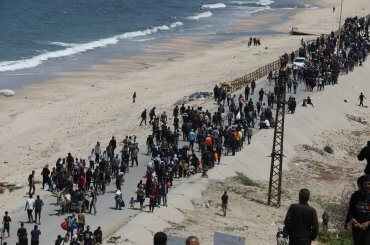Timothy Snyder’s new book Bloodlands defines the Holocaust as being the German chapter of a larger genocidal motion across eastern Europe, and initiated by the Soviet Union, in which 14 million were killed. From Neil Ascherson’s review in the Guardian:
The time is between about 1930 – the start of the second Ukraine famine – and 1945. The zone is the territory that lies between central Poland and, roughly, the Russian border, covering eastern Poland, Ukraine, Belarus and the Baltic republics. Snyder’s “Bloodlands” label is jarring, a title those beautiful lands and those who now live there do not deserve. But it’s true that in those years and in those places, the unimaginable total of 14 million innocent human beings, most of them women and children, were shot, gassed or intentionally starved to death.
Snyder’s third aim is to correct, radically, the way we remember what happened. To start with, the public in western countries still tends to associate mass killing with “Nazi concentration camps”, and with Auschwitz in particular. Stalin is thought to have killed far more people than the Nazis by consigning millions to the gulag. But neither assumption is accurate.
In the Soviet Union, it now appears that, although about a million men and women perished in the labour camps, nine out of 10 gulag prisoners survived. Stalin’s great killing took place not in Siberia, but in the western Soviet republics, above all in Ukraine where in the 30s at least four million people died in man-made famines and in the slaughter of the “kulak” peasantry.
In the concentration camps of the Third Reich, a million prisoners died miserable deaths during the Nazi period. But 10 million others who never entered those camps were shot (mostly Jews), deliberately starved to death (mostly Soviet prisoners of war) or gassed in special “killing centres” which were not holding camps at all. At Auschwitz, the overwhelming majority of Jews were taken straight to the gas chambers on arrival….
Snyder insists that the colossal atrocities in his “bloodlands” have to be set inside a single historical frame. To look at them separately – for instance, to see Hitler’s crimes as “so great as to stand outside history”, or Stalin’s as a monstrous device to achieve modernisation – is to let the two dictators “define their own works for us”. This, too, is quaggy ground for historians. In the cold war and afterwards, claims that “Stalin was worse than Hitler”, or that “communism and fascism come to the same thing”, generated more heat than light. But Snyder doesn’t fall into such holes. He is saying that both tyrants identified this luckless strip of Europe as the place where, above all, they must impose their will or see their gigantic visions falter.

